Kitchen Tap Buying Guide
Kitchen Tap Buying Guide
Introduction
Whether you’re replacing old taps with new ones or buying them as part of a kitchen remodel, it’s important to consider both the aesthetics and functionality. But there’s a vast choice available, so it’s worth knowing all your options before buying.
This kitchen tap buying guide runs through all the essential things you need to know. It includes how to choose the right kitchen taps, the types of kitchen taps and tap fittings available, and tap designs and finishes. It advises on installation and maintenance, lists the key things to consider before buying, and answers some frequently asked questions.
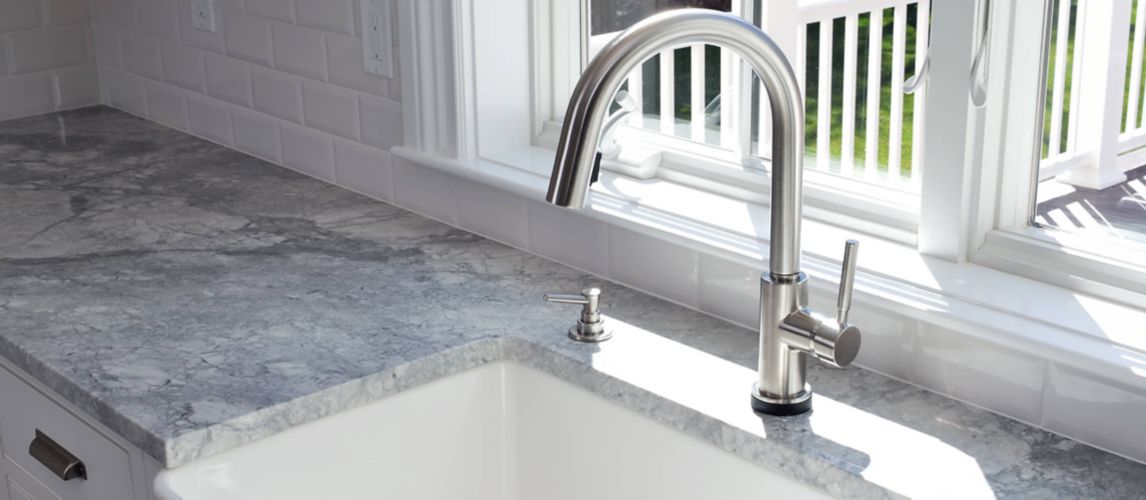
How Does a Tap Work?
Kitchen taps are connected to cold and hot water supplies. When the tap is on, a valve inside moves up to open a water chamber, allowing water to flow out of the spout. When the tap is off, the valve moves down and closes the chamber to stop the flow.
When buying a kitchen tap, it's essential to consider the home's water pressure, as some taps only work with high-pressure systems. High-pressure systems are those with either a combi boiler or an unvented system (where there's hot water storage but no cold water storage). However, a low-pressure system is a gravity-fed system (i.e., with cold water storage in the loft and a hot water cylinder in the airing cupboard).
Choosing the Right Kitchen Tap
Before choosing kitchen taps, consider how they need to work with the kitchen sink and the available space. For example, sinks can come with one, two or no tap holes. So, if there's one hole, you'll need a monobloc mixer tap. On the other hand, you'll need pillar taps or a deck-mounted mixer tap where there are two holes. And, if there are no holes, you'll need to install taps into the worktop behind the sink. In addition, some taps have higher spouts than others, so the tap height needs to be considered if there is a shelf above the sink.
Another important thing to consider is the kitchen style and whether you want to match the tap to the rest of the kitchen décor, choosing traditional or contemporary kitchen taps as appropriate.
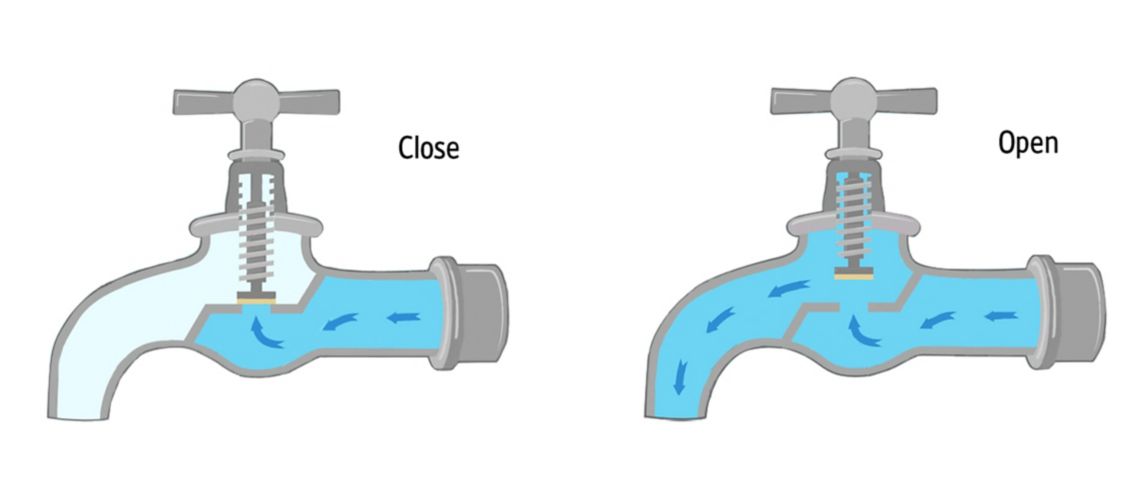
Types of Kitchen Taps
There are many different types of kitchen taps to choose from, so it’s important to understand all the options before buying.
Kitchen taps are commonly either single or twin lever taps. Single lever taps are mixer taps with one lever to control the water flow and mix hot and cold water to adjust the temperature. Twin lever taps have separate controls for the hot and cold water so that you can mix them manually.
Kitchen taps come in different shapes, too, such as:
- F-shaped
- U-shaped
- Pull-out
- Spring-necked
This section lists the different types of taps available, looks at their pros and cons, and explains what situation they are best suited to.
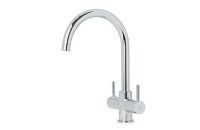
Kitchen mixer taps explained
Modern mixer taps supply hot and cold water separately, but they mix the flow and deliver it out of one spout. There are two types of mixer taps available, and they can control the water in different ways:

Deck-mounted kitchen taps
Deck-mounted kitchen taps are a type of mixer tap that uses two tap holes but only has one spout. The hot and cold sides of the tap are joined together by a pipe (called a bridge), which then joins the spout. They have twin levers or handles to control hot and cold water supplies separately.
Deck-mounted kitchen taps come in traditional and contemporary designs and are suitable for all households. They provide better control over the water temperature as it flows from the tap compared to non-mixer taps. However, the user must manually mix the hot and cold water to get it to a suitable temperature, which may be difficult for children.
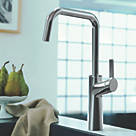
Monobloc mixer taps
Monobloc kitchen taps are mixer taps that draw hot and cold water supplies through one neck and spout. They are available in both single and twin lever options in traditional and contemporary styles and are suitable for sinks with one tap hole.
As with all mixer taps, monobloc kitchen taps provide better control over the water temperature as it flows from the tap, so scalds and burns can be avoided. But the single option is best for homes with small children.
There are many pros to installing mixer taps. They provide better control over the water temperature as it flows from the tap, so scalds and burns can be avoided. They’re more convenient than separate taps when filling the sink as it’s easier to get the mix of hot and cold water right compared to using separate taps. And people tend to use less hot water when mixing it into a single flow, which helps save money on energy bills and is better for the environment.
Due to their convenience, mixer taps are ideal for all homes, with the single lever option being the best type of kitchen tap for homes with children.
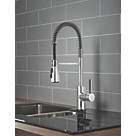
Pull-out kitchen taps explained
A pull-out kitchen tap is a mixer tap with a pull-out nozzle at the end of the spout, attached to a retractable hose. The nozzle enables the user to direct a high-pressure jet of water where they need it. For example, to clean debris off pots and pans or to clean the sink. They are very beneficial when washing large items or reaching areas a standard tap can't get to. They're suitable for all homes and are particularly useful in busy kitchens.
Pull-out kitchen taps most commonly have a single neck, requiring a sink with one tap hole. But there are some deck-mounted versions that need two tap holes available. They are also available in single and twin lever options.
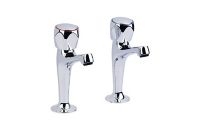
Kitchen pillar taps explained
Kitchen pillar taps are separate taps that come in pairs: one to supply hot water and one to supply cold water, operating independently of each other. They are suitable for sinks with two tap holes.
One advantage of kitchen pillar taps is that they tend to be cheaper than other types of taps and are easy to install. But you can’t control the hot water temperature beyond the settings on the home’s boiler, which means there is a risk of scalding when using hot water straight from the tap. However, you can mix hot and cold water in the sink to get the right temperature.
Kitchen pillar taps are not recommended for homes with small children due to the risk of scalding. However, they suit homes with traditional-style kitchens.
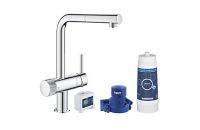
Filter taps explained
A filter tap is a type of mixer tap which filters impurities from the water as it's used. They look like any other mixer tap, but they're connected to a fitted filtering unit under the sink.
Filter taps provide many advantages. For example, they make water taste better and are a convenient, cost-effective, and environmentally friendly alternative to using a filter jug or buying bottled water. They also reduce the amount of limescale in kettles and other appliances.
There are some disadvantages, such as the filtering system taking up cupboard space, a requirement for professional installation, and the need for periodic maintenance. There are also ongoing costs because the filter cartridges need to be replaced every 6-12 months.
Filter taps are available in monobloc designs, in traditional and contemporary styles, and with single or twin levers.
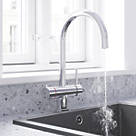
Boiling water taps explained
A boiling water tap is a mixer tap that provides an instant supply of boiling water and a conventional hot and cold water supply. It looks like any other mixer tap, but it's connected to a boiler tank, which is usually fitted under the sink.
There are many advantages to installing a boiling water tap. For example, they're convenient and much quicker than waiting for a kettle to boil. They're also energy-efficient and better for the environment because you boil precisely the amount of water you need each time. In addition, most have built-in carbon filters which remove impurities from the water to reduce limescale and make the water taste better. And they also have safety features to protect against accidental scalding.
There are some disadvantages, such as the boiler tank taking up cupboard space, and professional installation is required. They also need periodic services and filter changes which can range in frequency from every six months to every five years, depending on the make and model you buy.
Boiling water taps are available in monobloc and deck-mounted options, with single or twin levers, in traditional and contemporary designs.
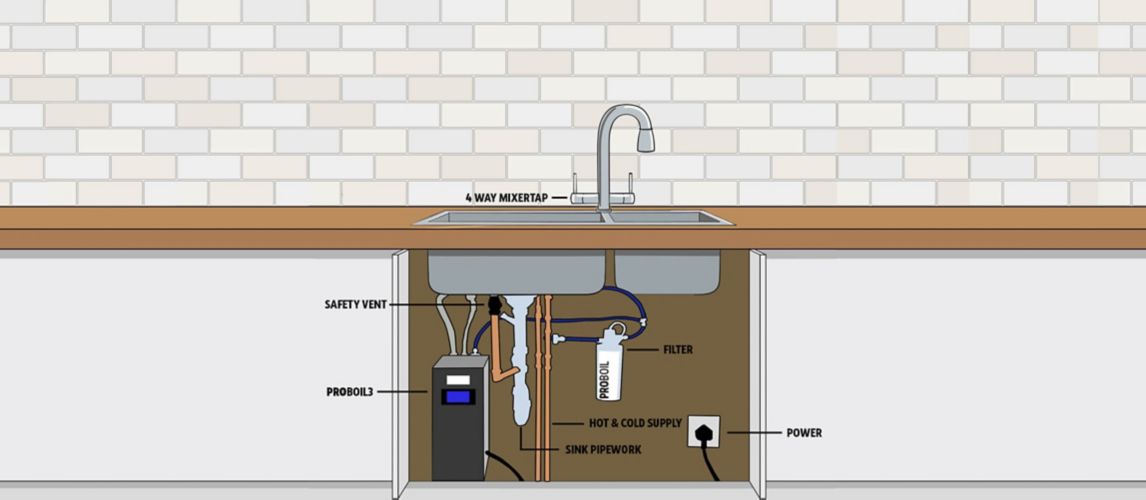
Types of Kitchen Tap Fittings
Most kitchen taps come with everything you need to fit them. However, you may need to buy extra plumbing parts, such as flexible hoses, washers, and PTFE tape, which are sold separately. It’s also possible to purchase reviver kits and tap spares to repair or update broken or tired-looking taps.
Kitchen Tap Design and Finishes
Kitchen taps are available in a wide range of designs, colours, and finishes and with different types of tap handles. Most people pick taps to match their kitchen décor, and various styles are available, from contemporary and designer kitchen taps to traditional and country kitchen taps.
The most popular tap finish is chrome because it works well in any style and colour kitchen. It also sparkles when it’s clean, as do chrome stainless steel, brushed nickel and brushed steel taps. However, there are other colours and finishes. For example, graphite, black and matt black kitchen taps look sleek in contemporary kitchens, although traditional designs are available too. There are also antique brass, brushed brass, antique bronze and copper kitchen taps which come in classic and modern designs.
Installation and Maintenance of Kitchen Taps
Replacing or installing a new kitchen tap can be difficult, so you may need a professional plumber. However, when it comes to installing a filter or boiling water tap, hiring a professional is a must.
A professional can remove and fit a standard kitchen tap in around thirty minutes, and it may take a few hours to install a filter or boiling water tap. If they’re removing and replacing an existing tap, the work may take longer if the plumbing fixtures need to be adjusted or they need to change the sink to suit the new tap.
Once the tap is fitted, follow these cleaning and maintenance tasks to keep it looking and working like new:
- Dry the tap with a soft cloth after every use.
- Clean the tap at least once a week with a damp cloth and mild cleanser – always check the cleanser used is suitable for the tap’s finish.
- Use a limescale remover weekly to prevent a build-up.
- Ensure boiler tap filters are changed and they are professionally serviced at the frequency recommended by the manufacturer.
- Ensure filter tap cartridges are changed as and when needed and follow the manufacturer’s recommendations for cleaning.
Key Considerations When Buying Kitchen Taps
The information above should help you decide which is the best type of kitchen tap for your needs. But there are a few more things to consider before making your final choice:
-
What will the kitchen taps mainly be used for?
The tap is one of the most used items in a kitchen, so it’s important to consider how it could be used to ensure you don’t miss out on useful features. For example, would a pull-out tap be helpful for quickly washing multiple pots and pans? Are there regular tea and coffee drinkers in the home who would benefit from a boiling water tap? Or could a water filter jug be replaced by a filter tap? -
What is the water pressure like?
Considering a home's water pressure is crucial when buying a kitchen tap. If the house has a low-pressure gravity-fed water system (i.e., with cold water storage in the loft and a hot water cylinder in the airing cupboard), the tap must be suitable for low-pressure systems. If it isn't, the flow of hot water will be poor, or it may not work at all. -
What about the water type?
Consider installing a filter tap if the home is in a hard water area. Not only will the filter make the water taste better, but it will also reduce limescale build-up in appliances (i.e., kettles and coffee machines) and on the sink.
